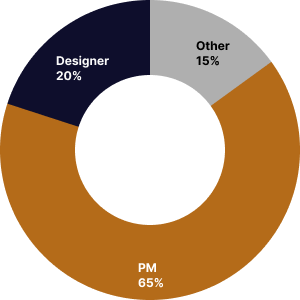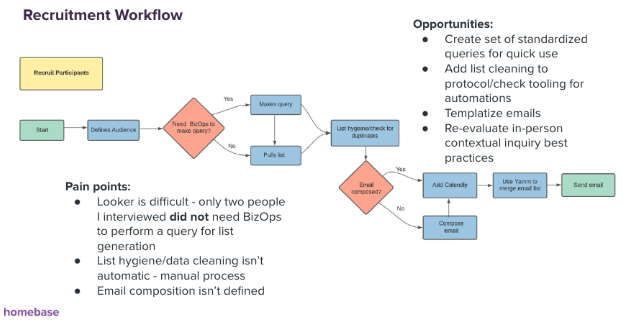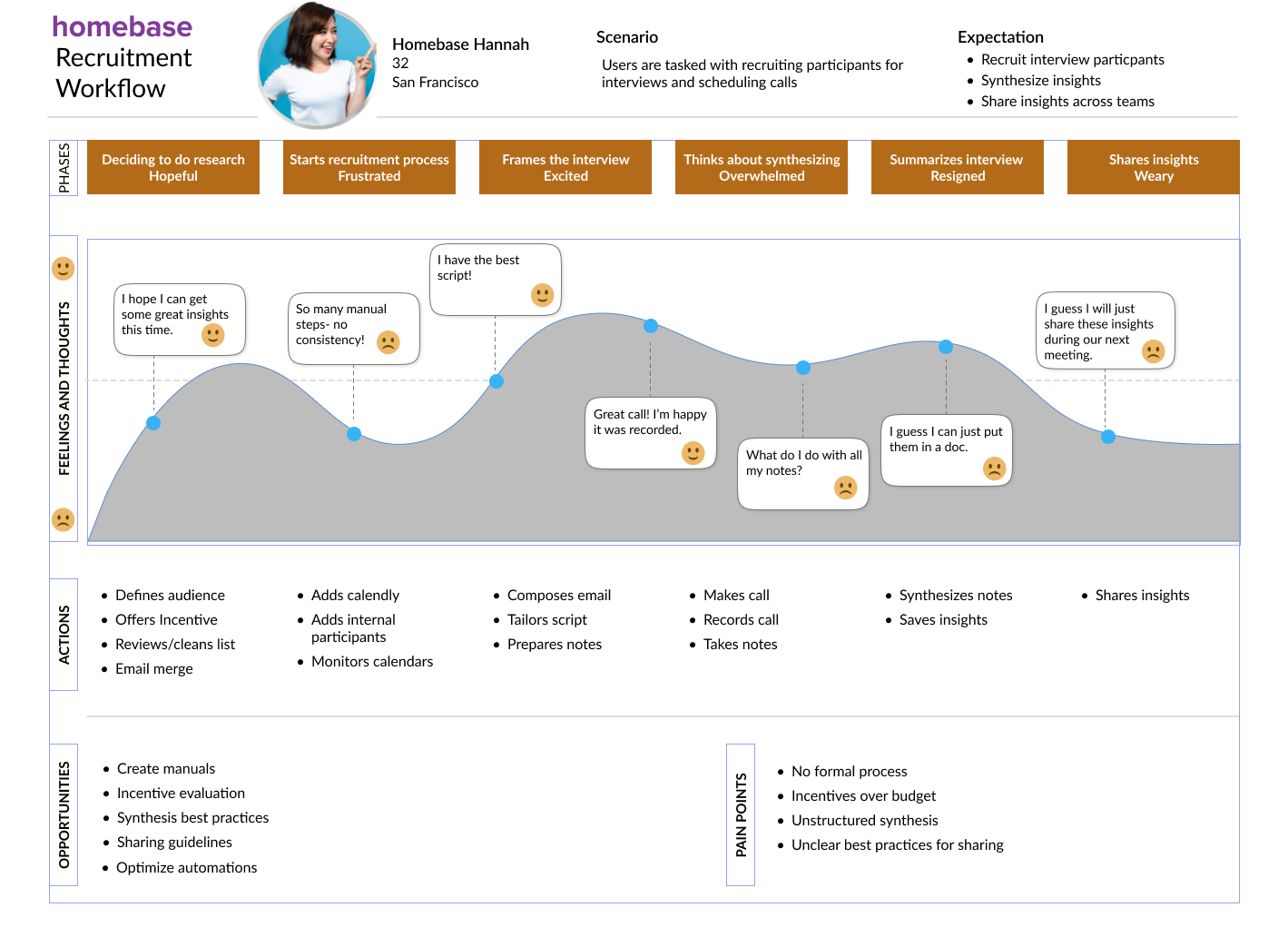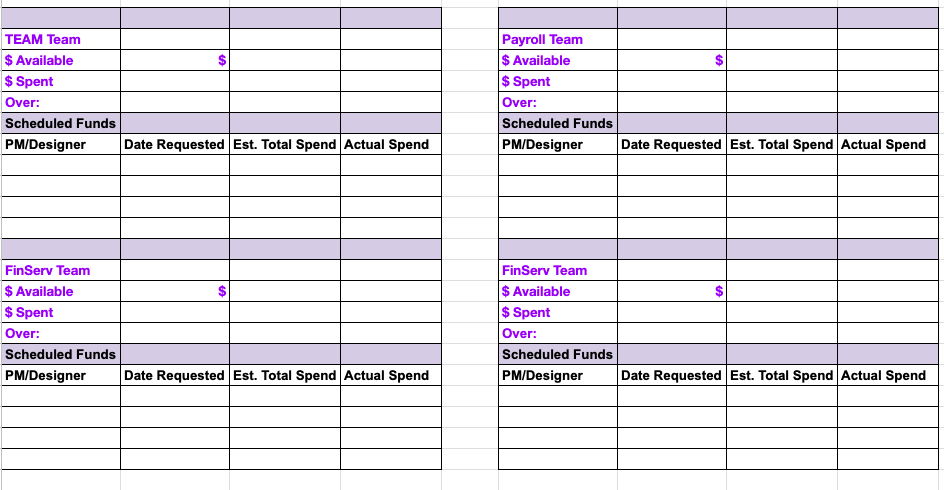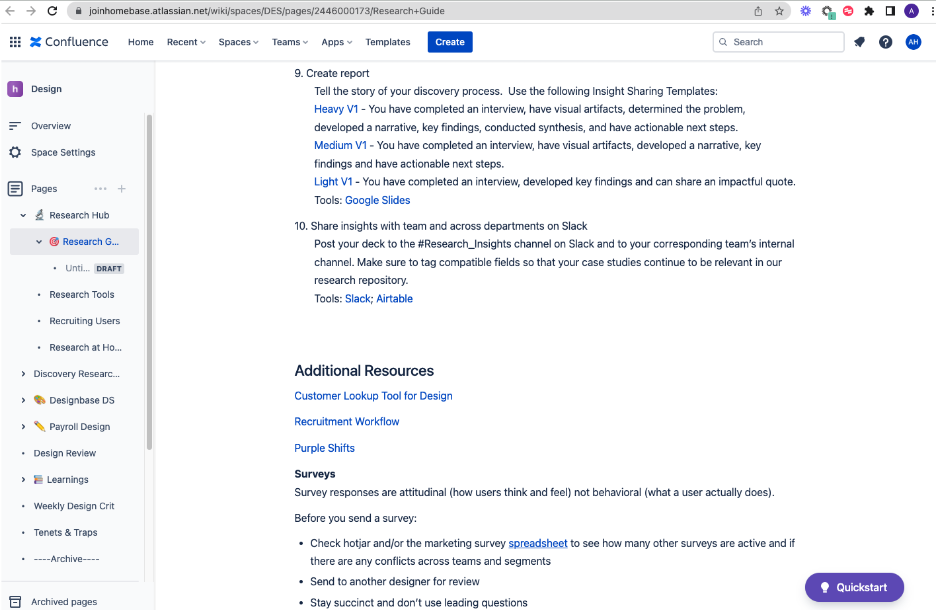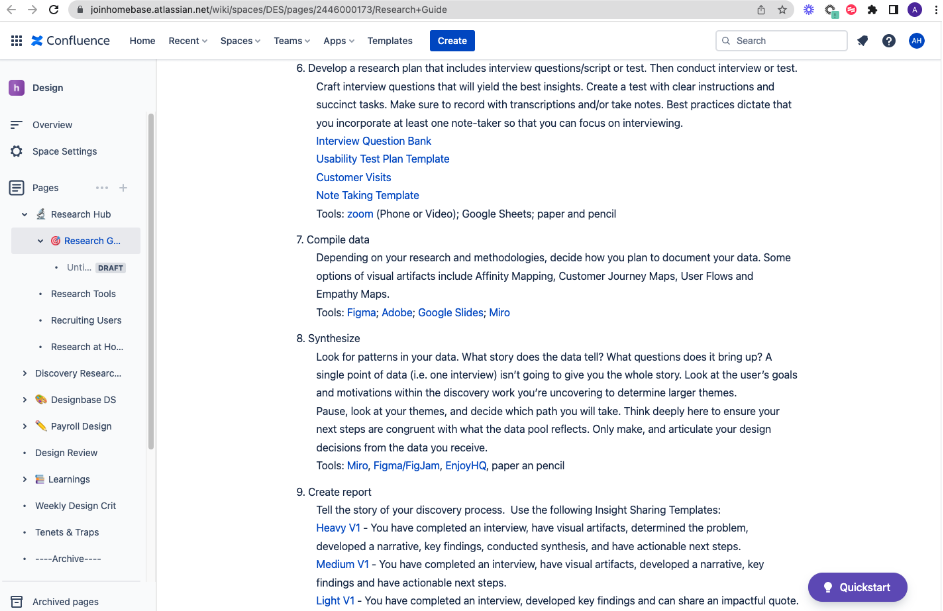Operationalizing the Research Program at Homebase
Context & Challenge
Homebase is a software company that builds tools for small businesses and their employees. To move quickly and make confident product decisions, teams across Product, Design, and Engineering needed frequent, reliable access to customer insights.
While there was an existing framework for recruiting participants for discovery work, it was cumbersome and inconsistent. Employees often struggled with time-consuming recruitment efforts, and there was no clear process for synthesizing or sharing insights across teams. This created knowledge silos, duplicated efforts, and a lack of trust in the research process.
What Homebase needed was a scalable, self-sufficient system for conducting, synthesizing, and sharing user research — one that didn’t depend on a dedicated researcher at every step.
My Approach
To meet this need, I designed and implemented a self-service research guide that gave employees a clear, repeatable framework for conducting research. The guide included step-by-step instructions, templates, and protocols for everything from participant recruitment to insight sharing. My goal was to reduce friction, build research confidence, and ensure that insights were both accessible and actionable.
Below, I outline how I identified the core challenges, mapped opportunities for operational improvement, and delivered a sustainable solution that now supports teams across the organization.
🔍 Overview
Category
UX Research · Research Operations
Role & Team
UX Researcher (solo)
Collaborated with Product, Design & Engineering stakeholders
Duration
3 months
Tools
Confluence · Google Suite · Lucidchart · Figma
🎯 Project Objectives
Over the course of this 3-month engagement, I led the creation of a scalable, self-service research process by:
✅ Surfacing consistent pain points across roles and departments to identify key blockers
⚙️ Uncovering opportunities for automation and tooling to reduce manual work
🔁 Delivering a lightweight, repeatable system for recruitment, synthesis, and insight sharing
Hypothesis & Assumptions
A successful research process must be low-overhead and easy to maintain across teams.
The existing recruitment workflow is inefficient and time-consuming, limiting research momentum.
By introducing a lightweight, repeatable framework for recruitment, synthesis, and insight-sharing, Homebase employees can conduct effective research independently, without relying on a full-time researcher
Discovery & Approach
I applied industry-standard research methods to develop a scalable, sustainable solution to the problem.
My initial discovery phase focused on understanding employee behaviors, perceptions, and pain points related to research. I conducted qualitative interviews with over 20 Homebase team members across departments to learn how they currently approached participant recruitment and qualitative research.
By mapping their workflows and surfacing common friction points, I was able to identify consistent gaps in process, tooling, and support — all of which shaped the foundation for a more efficient and repeatable system.
Who I talked to:
13 PMs
4 Designers
3 Other
(Marketing & CS)
I synthesized the interview insights into an affinity map, surfacing patterns and themes that cut across roles and departments.
I categorized findings by attitudinal and behavioral dimensions, organizing them into key areas such as process, incentives, tooling, and knowledge sharing. This structure helped clarify where misalignments occurred — and where opportunities for impact were most concentrated.
Synthesis
Homebase employees were highly motivated to engage in research and recognized its value in driving better design decisions. However, the existing process often felt like a barrier—cumbersome, unclear, and time-consuming.
By simplifying participant recruitment and establishing a clear framework for synthesis and sharing, I aimed to turn research from a bottleneck into a catalyst. Empowering teams with accessible tools and repeatable workflows would not only increase participation but also improve the quality and visibility of insights across departments.
Visualizing the Research Journey: End-to-end user flows highlighting pain points in recruitment, scheduling, and documentation.
Once key themes were established, I mapped the end-to-end user flows for recruitment, scheduling, and documentation as experienced by Homebase employees. These visual workflows revealed critical friction points and uncovered clear opportunities for streamlining and support.
After mapping the recruitment, scheduling, and documentation workflows, I discovered a critical gap: there was no established process for synthesizing or sharing research findings.
This insight became a key driver in my solution design, prompting the creation of structured templates and guidelines to make synthesis and knowledge sharing both intuitive and repeatable across teams.
Journey Mapping the Recruitment Experience
To better understand the employee experience, I created a journey map that visualized the steps Homebase team members needed to take to recruit participants for research. This map captured not only the sequence of actions — from identifying participants to booking interviews — but also the emotions, obstacles, and workarounds encountered along the way.
By charting this process from the employee’s perspective, I was able to clearly identify friction points, redundant steps, and moments of confusion. This visual tool helped align stakeholders around the lived experience of internal users and served as a foundation for designing a more streamlined, scalable recruitment system.
📝 Research Brief Template
A lightweight framework to help designers clearly communicate research strategies and rationale to decision-makers.
Solutions
📊 Insight-Sharing Templates
Three flexible formats to streamline how findings are summarized and shared across teams, encouraging fast, cross-functional alignment.
🎁 Incentive Program Guidelines
Clear protocols for managing participant incentives — improving consistency, transparency, and ease of administration.
🔍 Smarter Data Retrieval
A tailored approach to customer data access, using refined search queries to speed up recruitment and reduce noise.
Testing & Iterations
After developing key components—including a research brief, incentive planner and tracker, insight-sharing templates, and an updated data inquiry dashboard—I conducted structured testing sessions with external users to evaluate usability, clarity, and real-world applicability.
These sessions provided valuable feedback on how intuitive and effective each solution was across different roles and use cases. I observed how users interacted with the tools, identified points of friction, and refined both content and layout based on their input.
By pressure-testing each element before rollout, I ensured the final toolkit was not only functional but also easy to adopt—minimizing the need for ongoing support and maximizing cross-team impact from day one.
The Solution
The final outcome was a comprehensive, step-by-step self-service research guide—a centralized, accessible resource that now serves as the single source of truth for research best practices at Homebase.
Designed for scalability and ease of use, the guide equips employees across Product, Design, and Engineering with everything they need to plan, conduct, synthesize, and share user research independently. From recruitment and scheduling to insight sharing and stakeholder communication, each component was created to reduce friction, increase confidence, and promote consistency.
Today, this guide is widely adopted across teams and used regularly to answer critical product questions with speed, structure, and rigor—allowing Homebase to stay user-centered while moving fast.
